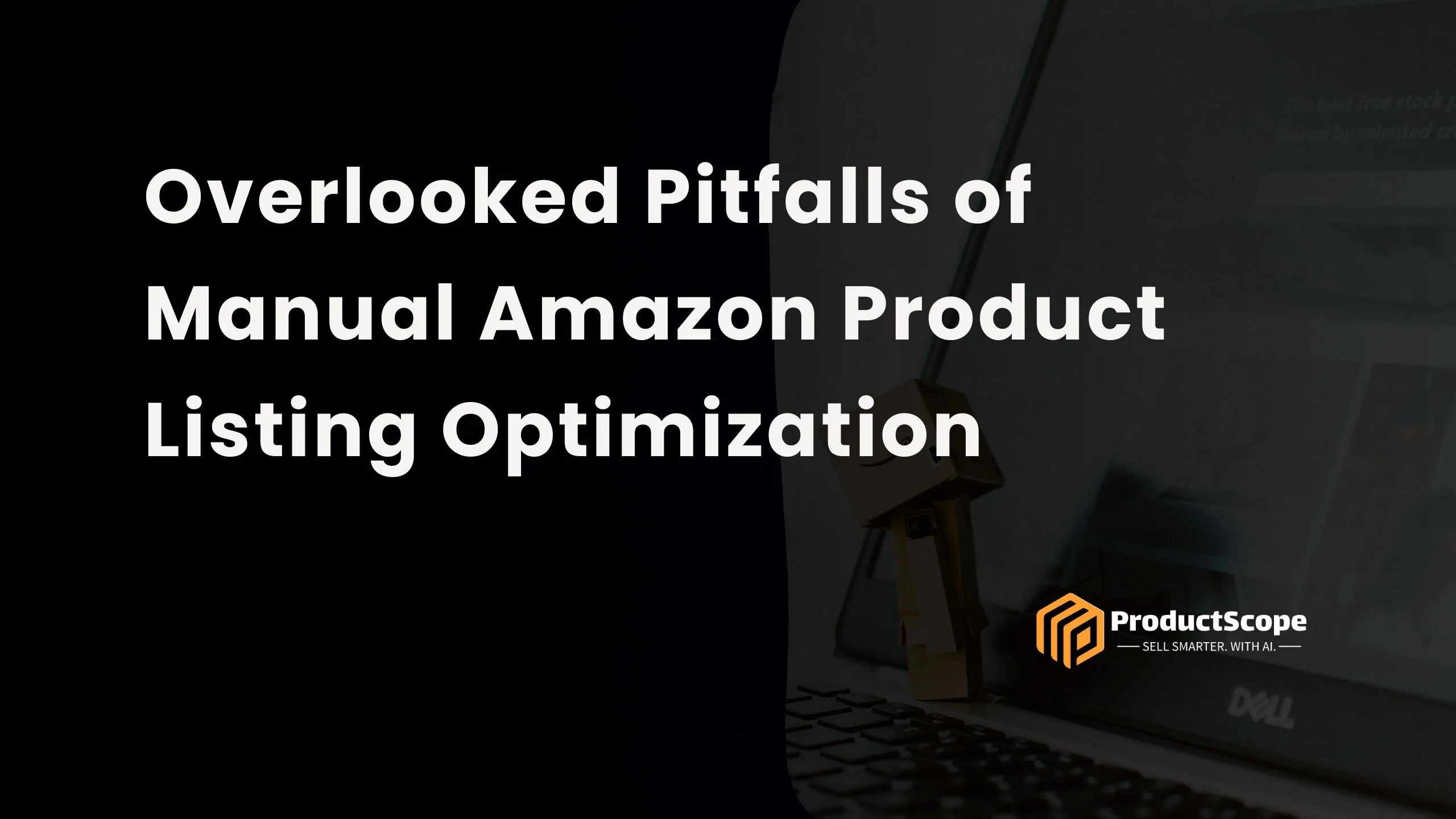Amazon product listing optimization is a crucial aspect of e-commerce success, yet it’s fraught with overlooked pitfalls that can hinder your sales and visibility. As an e-commerce brand owner, understanding these pitfalls is essential to avoid common mistakes and leverage your Amazon presence effectively.
This article delves into the nuances of manual optimization, highlighting key areas often missed by sellers.
Common Mistakes in Amazon Listing Optimization

Incomplete Keyword Research
Incomplete keyword research can have detrimental effects on a seller’s product visibility on Amazon. Without conducting thorough keyword research, sellers may miss out on valuable opportunities to optimize their product listings and reach their target audience. By neglecting this crucial step, sellers risk not fully understanding the search terms and phrases that potential customers are using to find products similar to theirs. This can result in their products being buried in search results or not appearing at all, ultimately leading to lower visibility and fewer sales.
Furthermore, incomplete keyword research can also lead to suboptimal product visibility because sellers may fail to identify relevant long-tail keywords that have less competition but higher conversion rates. These long-tail keywords are often more specific and targeted, allowing sellers to reach a more qualified audience who are actively searching for their specific product. By not uncovering these valuable keywords, sellers miss out on the opportunity to optimize their product listings with the most relevant and high-converting keywords, which can significantly impact their visibility and overall success on Amazon.
Not Maximizing for Indexing Opportunities
Not maximizing indexing opportunities on Amazon can severely limit a seller’s product discoverability. It is crucial to understand how Amazon’s indexing mechanism works and leverage it to your advantage. By incorporating a diverse range of relevant keywords in your product listing, you increase the chances of your product being indexed for various search terms. This means that when potential customers search for related keywords, your product has a higher likelihood of appearing in the search results, leading to increased visibility and potential sales.
Furthermore, not maximizing indexing opportunities can result in missed chances to target specific customer segments. By strategically incorporating keywords that cater to different customer preferences, demographics, or niches, you can expand your reach and attract a wider audience. For example, if you sell a skincare product that is suitable for both men and women, optimizing your listing with gender-specific keywords can help you target each segment effectively. By neglecting to maximize indexing opportunities, sellers limit their product’s exposure and miss out on the chance to attract a broader range of potential customers.
Keyword Stuffing in Titles
Keyword stuffing in titles can have negative consequences for a seller’s product listing on Amazon. While it is important to include relevant keywords in the title to improve discoverability, overloading it with excessive keywords can make the title appear spammy and unappealing to potential customers. This can result in a lower click-through rate and decreased customer interest. It is crucial to strike a balance between keyword inclusion and readability in order to create a title that not only attracts attention but also provides valuable information about the product.
By focusing solely on keyword stuffing, sellers risk sacrificing the readability and coherence of their titles. Customers are more likely to be drawn to titles that are clear, concise, and easy to understand. A cluttered title filled with an excessive number of keywords can confuse customers and make it difficult for them to grasp the main features or benefits of the product. Therefore, it is important to prioritize readability while still incorporating relevant keywords strategically. This ensures that the title effectively communicates the value proposition of the product while also improving its visibility in search results.
Hidden Opportunities in Amazon Listing Optimization

Maximizing Image Slots
Maximizing image slots is crucial for effectively showcasing a product and capturing the attention of potential customers. Images are a powerful tool in product representation as they provide visual cues and allow customers to get a better understanding of the item they are considering purchasing. By utilizing all available image slots, sellers can provide a comprehensive view of the product from different angles, highlighting its features, details, and functionality. This not only enhances customer perception but also builds trust and confidence in the product’s quality.
High-quality pictures are essential for making a positive impression on customers. Clear, well-lit, and professionally taken images can significantly impact customer perception and increase the likelihood of a purchase. When all image slots are utilized with high-quality pictures, customers can have a more immersive and engaging shopping experience. They can zoom in to examine the product closely, see its texture, color, and other important details. This level of visual information helps customers make informed decisions and reduces the chances of dissatisfaction or returns. Therefore, maximizing image slots with high-quality pictures is an effective strategy to enhance customer perception and drive sales.

Incorporating Videos
Incorporating videos into product representation is a powerful way to captivate customers and increase their engagement. Unlike static images, videos offer a dynamic and interactive experience that can effectively showcase the product’s features, functionality, and benefits. By incorporating videos, sellers can provide a more comprehensive view of the product, allowing customers to see it in action and understand how it can meet their needs. This immersive experience not only grabs attention but also creates a deeper connection with the product, increasing the likelihood of a purchase.
Videos also have the advantage of being able to convey emotions and tell a story. Through visual storytelling, sellers can create a compelling narrative around their product, evoking emotions and building a stronger connection with customers. Whether it’s demonstrating how the product solves a problem or showcasing its versatility, videos have the power to engage customers on an emotional level. This emotional connection can lead to increased trust, loyalty, and ultimately, higher sales. Incorporating videos into product representation is an effective strategy to enhance customer engagement and create a memorable shopping experience.
Leveraging A+ Content
Leveraging A+ Content is a strategic approach to showcase your brand’s unique story and highlight the key features of your product. A+ Content provides sellers with the opportunity to create visually appealing and informative product descriptions that go beyond the limitations of traditional text-based listings. By incorporating high-quality images, engaging videos, and compelling copy, A+ Content allows brands to create a more immersive and persuasive shopping experience for customers.
One of the key advantages of A+ Content is its ability to differentiate your product from competitors. With the increasing competition in the online marketplace, it’s crucial to stand out and make a lasting impression on potential customers. A+ Content enables sellers to showcase their product’s unique selling points, explain its benefits in detail, and effectively communicate why it is superior to similar offerings in the market. By leveraging A+ Content, brands can effectively communicate their value proposition and build trust with customers, ultimately increasing their chances of making a purchase.
Advanced Strategies for Avoiding Pitfalls

Understanding Amazon’s Unique SEO Dynamics
Understanding Amazon’s unique SEO dynamics is essential for sellers looking to optimize their product listings and increase visibility on the platform. Unlike traditional search engine optimization (SEO), where the focus is primarily on website rankings, Amazon’s SEO is centered around product rankings within its own marketplace. This means that sellers need to adapt their strategies to align with Amazon’s algorithms and ranking factors.
One key difference in Amazon’s SEO dynamics is the emphasis on product relevance and conversion rates. While traditional SEO focuses on keywords and backlinks, Amazon’s algorithm prioritizes factors such as product title, description, and customer reviews. Optimizing these elements with relevant keywords and compelling copy is crucial for improving product visibility and increasing conversions. Additionally, factors like pricing, availability, and fulfillment options also play a significant role in Amazon’s SEO, as they directly impact the customer’s buying decision.
Utilizing Special Amazon Programs
Utilizing special Amazon programs such as Amazon Vine and Brand Registry can provide sellers with distinct advantages in terms of product visibility, credibility, and protection. Amazon Vine is an invitation-only program that allows sellers to provide their products to trusted reviewers in exchange for honest and unbiased reviews. By participating in this program, sellers can generate a significant number of authentic reviews, which not only helps build trust with potential customers but also improves product rankings on Amazon. The reviews generated through Amazon Vine are labeled as “Vine Voice” reviews, which adds an extra layer of credibility to the feedback.
On the other hand, Brand Registry is a program designed to help sellers protect their brand and intellectual property rights on Amazon. By enrolling in Brand Registry, sellers gain access to tools and features that allow them to monitor and control their brand presence on the platform. This includes the ability to create and manage a unique brand store, protect against counterfeit listings, and utilize enhanced content options like A+ Content. By leveraging these features, sellers can establish a strong brand identity, differentiate themselves from competitors, and provide a more engaging shopping experience for customers.

Importance of Customer Reviews and Questions
Customer reviews and questions play a crucial role in the success of a product on Amazon. They provide valuable insights into the customer experience, allowing sellers to understand what aspects of their product are working well and what areas need improvement. By paying attention to customer feedback, sellers can optimize their products to better meet the needs and preferences of their target audience.
Customer reviews serve as social proof and can significantly influence purchasing decisions. Positive reviews can build trust and credibility, encouraging potential customers to choose a particular product over its competitors. On the other hand, negative reviews can highlight areas of improvement and give sellers an opportunity to address any issues or concerns raised by customers. By actively responding to customer feedback and making necessary improvements, sellers can enhance their product’s relevance and appeal, ultimately leading to increased sales and customer satisfaction.
Leveraging AI Product Optimization
AI can analyze vast amounts of data and identify patterns and trends that humans may overlook. By leveraging AI algorithms, businesses can gain valuable insights into customer preferences, behavior, and feedback. This information can then be used to optimize products to better meet the needs and expectations of customers. For example, AI can analyze customer reviews and identify common themes or issues raised by customers. This allows businesses to make necessary improvements or address concerns promptly, ultimately enhancing the product’s relevance and appeal.
Furthermore, AI can also help in predicting future trends and demands. By analyzing market data and consumer behavior, AI algorithms can provide businesses with valuable insights into emerging trends and customer preferences. This enables businesses to proactively adapt their products to meet changing market demands, giving them a competitive edge.
Conclusion
This article has explored various aspects of Amazon product listing optimization, emphasizing the importance of avoiding common mistakes and leveraging hidden opportunities. Applying these strategies can significantly enhance your product’s performance on Amazon.
Elevate your Amazon listings with ProductScope’s innovative optimization tool. Master Amazon SEO by strategically integrating high-impact keywords, tailored to your unique customer insights. Say goodbye to keyword stuffing and hello to SEO-optimized content that resonates with both customers and search engines. Ready to boost your visibility and ranking on Amazon? Discover ProductScope’s Amazon Listing Optimizer today!
FAQs
What Are the Most Common Mistakes in Manual Amazon Listing Optimization?
Incomplete keyword research, not maximizing indexing opportunities, and keyword stuffing in titles are among the most common mistakes.
How Does Amazon’s SEO Differ From Traditional Search Engine SEO?
Amazon’s SEO focuses more on sales-driven factors like conversion rates and customer purchasing behavior, unlike traditional SEO.
What Role Do Customer Reviews Play in Amazon Listing Optimization?
Customer reviews are crucial as they provide social proof, influence buyer decisions, and can improve a product’s search ranking.
How Important Is Keyword Research in Amazon Listing Optimization?
Keyword research is vital for ensuring the product appears in relevant searches, leading to increased visibility and sales.
Can Poor Amazon Listing Optimization Affect Sales?
Yes, poor optimization can lead to lower visibility, reduced traffic, and missed sales opportunities. Effective optimization is key to attracting potential buyers.

